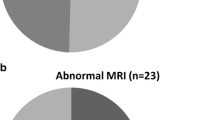Abstract
Introduction
Tectal beaking is a common finding in children born with a myelomeningocele. Quantitation of the presence or absence of this finding correlated with normal or abnormal eye movements is lacking in the medical literature.
Materials and methods
We prospectively evaluated 50 children in our multidisciplinary spina bifida clinic. Each child was observed for the presence or absence of nystagmus at rest or with extraocular movement. Grades of nystagmus and severity of tectal beaking (Types I–III) on MRI were then correlated.
Results
Overwhelmingly, children with greater dysmorphology of the mesencephalic tectum were most likely to have nystagmus. Higher grades of nystagmus were associated with Type III tectal beaking.
Conclusions
We have demonstrated that there is a correlation between the presence and severity of nystagmus and the severity of tectal beaking and have quantified this association in patients with the Chiari II malformation. This information may act as a guide in predicting which children with the Chiari II malformation will have significant nystagmus. These data may aid the clinician in the interpretation of oculomotor abnormalities in this cohort of patients.

Similar content being viewed by others
References
Adeloye A (1976) Mesencephalic spur (beaking deformity of the tectum) in Arnold-Chiari malformation. J Neurosurg 45:315–320
Cameron AH (1957) The Arnold-Chiari and other neuro-anatomical malformations associated with spina bifida. J Pathol Bacteriol 73:195–211
Chiari H (1891) Über Veränderungen des Kleinhirns infolge von Hydrocephalie des Grosshirns. Dtsch Med Wochenschr 17:1172
Cleland J (1883) Continuation to the study of spina bifida, encephalocele, and anencephalus. J Anat Physiol 17:257–292
Daniel PM, Strich SJ (1958) Some observations on the congenital deformity of the central nervous system known as the Arnold-Chiari malformation. J Neuropathol Exp Neurol 17:255–266
Lennerstrand G, Gallo JE, Samuelsson L (1990) Neuro-ophthalmological findings in relation to CNS lesions in patients with myelomeningocele. Dev Med Child Neurol 32:423–431
Oakes WJ, Tubbs RS (2004) Chiari malformations. In: Winn R (ed) Youman’s neurological surgery, vol 3, 5th edn. Saunders, Philadelphia, pp 3347–3361
Peach B (1965) The Arnold-Chiari malformation morphogenesis. Arch Neurol 12:527–535
Sener RN, Dzelzite S (2003) Rhombencephalosynapsis and a CIIM. J Comput Assist Tomogr 27:257–259
Tubbs RS, Wellons JC III, Grabb PA, Oakes WJ (2003) Chiari II malformation and occult spinal dysraphism. Case reports and review of the literature. Pediatr Neurosurg 39:104–107
Author information
Authors and Affiliations
Corresponding author
Rights and permissions
About this article
Cite this article
Tubbs, R.S., Soleau, S., Custis, J. et al. Degree of tectal beaking correlates to the presence of nystagmus in children with Chiari II malformation. Childs Nerv Syst 20, 459–461 (2004). https://doi.org/10.1007/s00381-004-0948-9
Received:
Published:
Issue Date:
DOI: https://doi.org/10.1007/s00381-004-0948-9




